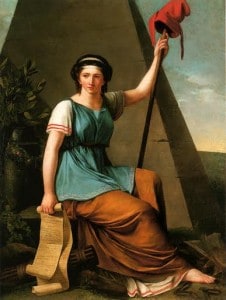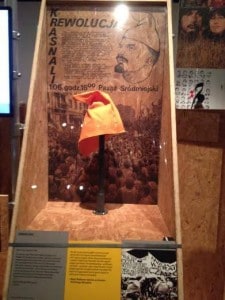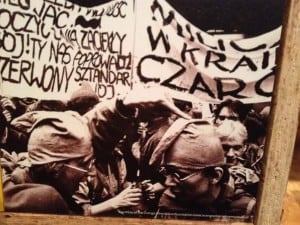A crockery, blanket, saucepan lid, gorilla mask – everyday life objects can be promoted to a rank of symbol or icon. They become mighty props on the scene of social or economic revolt. For Catherine Flood and Gavin Grindon who assembled a display presented currently at the Victoria and Albert Museum in London, these are ‘disobedient objects’. They tell us the story of counter-culture and portrait symbols of social change around the world.
The V&A’s presentation includes the objects form early 1970s up to year 2011. A Saucepan Lid (2001) was used in mass protests in Buenos Aires against peso denomination, and a rice bag wore by Korean farmers as a T-shirt in 2005 protested against the corporate globalisation. The Nike blanket (2003) petition was used as an anti sweat shop protest and points out the crisis of global expansion and the feminization of labour.
The beginning of counter-culture was on the end of the 1950s. A group of intellectuals and artists got together in 1957 as Situationists, heavily influenced by Surrealists and Dadaist, their avant-garde predecessors. Social revolutionaries leaded by Guy Debord proposed an art engaged in solving socio-political issues. Artists became activists and happening formed a new tool to bring a change to life and verify capitalism, criticize bourgeois careless way of living, church and state institutions. Roel Van Duyn established the Provo movement to ridicule consumptionism using numerous happenings in year 1964–1966. These events were later followed by the San Francisco’s Diggers – the name originated from the 17th century English diggers who attempted to farm on a common land.
One of the ‘disobedient’ objects enclosed to the V&A assembly is an inconspicuous orange cap. Since 1981 in Poland it was a symbol of surreal yet powerful, pacifist way to oppose the communist regime. The first and fairly obvious association with this object takes us to the end of the 18th century and decimal time of the French Revolution. The Phrygian cap (rouge bonnet), a red woollen-piece of garment was an early recognised symbol of the new social order. It became an icon of liberty. Back then, in 1789 it was used as an excuse for deprivation, worn by King and aristocracy as a disguise. It was never allowed to be worn by women. Paradoxically, this is the Marianne, an allegory of the French Republic who wears it till this day.
A search for the origins of the depiction of Marianne leads us to Henriade (1728) a poem by Voltaire. And its main character, Henry IV, an enlightened monarch praised by Voltaire for his appreciation of tolerance, peace and humanity. In 1775, Jean Michel Moreau was commissioned to illustrate this poem. He depicted the king along with Feronia, Roman goddess of liberty. Romans were known to emancipate slaves in Feronia’s temples by shaving their heads and putting the Phrygian cap on.

Project for illustrating The Henriade, drawing by Jean Michel Moreau, le Jeune, 1775, Copyright: © Musée national du château de Pau / Jean-Yves Chermeux

The goddess of Liberty is the future Marianne from Nanine Vallain and Eugène Delacroix’s paintings. The Phrygian cap become one of the most popular and powerful prop worn among others by William Blake or Jacques Cousteau. In pop culture it is attributed to characters like Steve Zissou (The Life Aquatic with Steve Zissou, 2004), Jaq and Gus (Cinderella and its two, 1950), Link (The Legend of Zelda, 1986) and Papa Smurf (Smurfs, 1958).
Its orange version became the trademark of the The Orange Alternative (Pomarańczowa Alternatywa). It was originated in 1981 as an anarchic and pacifistic movement against the communist regime in Poland. Its founder Waldemar Fydrych aka Major (Commander of the Festung Breslau), a former graduate in History of Art at the Wroclaw University drew from the surrealism, and dadaism but first of all from the experience of Situationists. It grew out from Kabouters (Gnomes Party) founded by Roel Van Duyn in early 1970s in Amsterdam as an alternative society.
The Orange Alternative members wore an orange cap. Symbolically, it was a combination of red, associated with communism and yellow connected to Catholic church. Time between 1986-1989 was the most productive for the Orange Alternative activities. A number of happenings were held around Świdnicka Street in Wroclaw but also all kind of prints like pamphlets, booklets and posters were produced and distributed.
To support the Orange Alternative actions an A Newspaper (“Gazeta A”) was published. No explicit demands were expressed by the Commissioners Council of the Orange Revolution (Major Fydrych, Wiesław Cupała). They create perverse manifestos combined of quotes from communist nomenclature art and philosophy to play with the system avoiding censorship.
Manifesto No 1
Independent art is one of the most powerful ways of fighting with reality and reality knows it.
Manifesto No 2
Because reality is the greatest and the oldest enemy of all human, schizophrenia appears as a quality refuge to us. Get out the intellectual art! Long live the socialist cartoon!
In 1988 the Gnomes Revolution was launched, the orange comrades voiced: Here’s to Yalta, Smurfs and Cars! Starting in Wroclaw at Swidnicka Street the Orange Alternative gradually spread over the other Polish cities like Poznan, Gdansk, Krakow and Warsaw.
During many of these happenings Communists’ writings were used in the perverse way. A good example of this attitude is happening performed during the Nowa Huta strikes in 1988. A letter by Lenin was read out to cheer the workers up. The other intervention took place in Wroclaw Zoo, where chimpanzees had an opportunity to appreciate the Stalinists’ hymns sung loudly by the participants gathered around their cages. The latest spectacular happening by the Orange Alternative was performed in December of 2004, in connection to the Orange Revolution events. Major Fydrych with a group of students joined the Revolution with a happening Kyiv – Warsaw – our Common Affair.
The V&A display presents how intellectuals and artists together with ordinary people incorporated plain objects, art and design to drive the social change. The orange cap represents one of the world’s very influential currents in the history of civic disobedience and anti-totalitarian struggle.
Words: Monika Waraxa
Proofreading: Dr. Suzanne Mackenzie
References:
Orange Alternative, http://www.pomaranczowa-alternatywa.org/orange%20alternative%20overview.html
Henri, Prince of Enlightenment, http://www.henri-iv.culture.fr/en/uc/05_02_00?
Disobedient Objects
Victoria and Albert Gallery
Porter Gallery
26/07/14–1/02/15
Biography:
Monika Waraxa (b. 1977) is a visual artist based in London. She writes for Obieg. She runs blogs on art: Critic Police, Monika Waraxa Blog and on pop culture: Celebrities Clash. She is currently focused on an audience engagement activities developed in a multimedia project: The Interchange. She is co-founder of Orange Boat for an innovative art education.

Orange cap, Disobedient Objects, V@A, London, photo Contemporary Lynx, August 2014

Exhibition view, Disobedient Objects, V@A, London, photo Contemporary Lynx, August 2014












